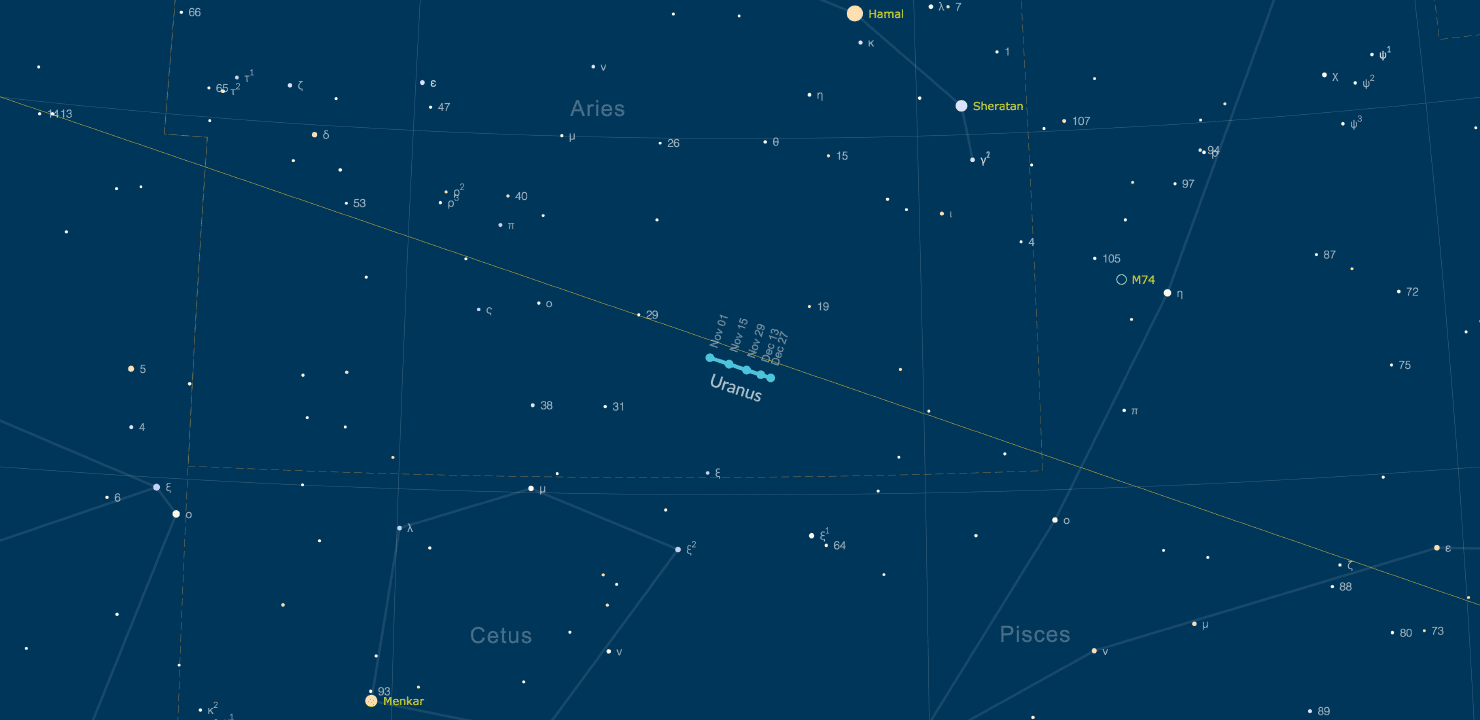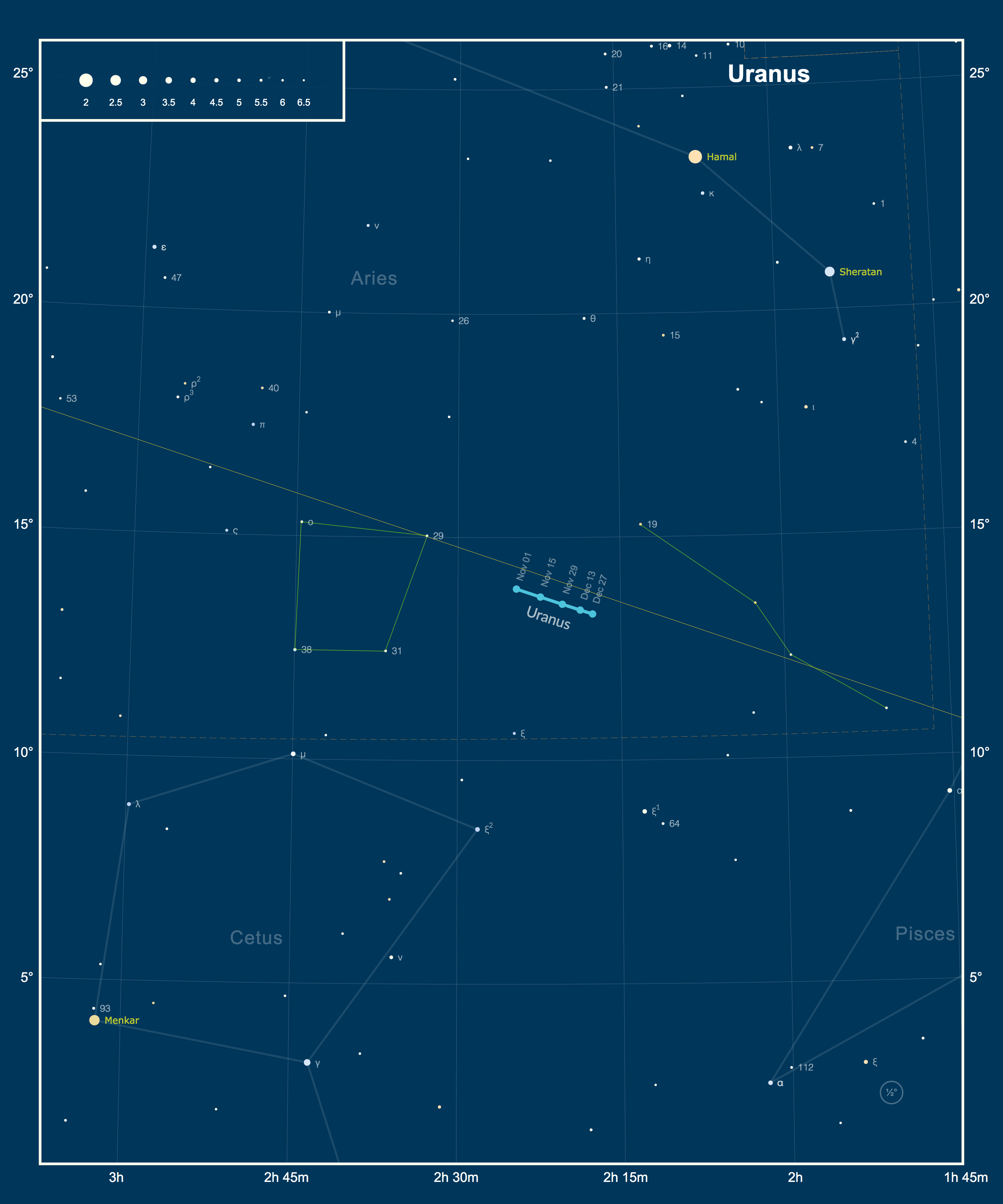
Finding Uranus
November 2020 :
Note: This article may contain outdated information
This article was published in the November 2020 issue of The Skyscraper and likely contains some information that was pertinent only for that month. It is being provided here for historical reference only.
For much of 2020, the impending conjunction of Jupiter and Saturn kept our attention towards the eastern edge of Sagittarius since late spring, as Jupiter slowly catches up with Saturn for what will be a spectacular conjunction on December 21. But as they draw nearer to each other they are also settling lower into the southwestern sky. By mid-evening they will depart the sky altogether, leaving only Mars to draw our planetary attention during the evening.
While we're slowly pulling away from Mars, it remains bright and high in our sky, and even next opposition in 2022 will not be as close as it is now, so give it as much attention as you can.
When you're finished visiting Mars, let's take a journey to our solar system's seventh planet.
Uranus reached opposition on the night of November 1-2. It is at its closest to Earth for the year, at a distance of 18.79 astronomical units (AU) at its opposition, and shows a tiny globe of just 3.8 arcseconds, which is about 1/9 of the separation distance of the double star Albireo in Cygnus.
Due to its large distance from Earth, observing Uranus at opposition compared with observing it during other times has little effect on its apparent size and brightness, but because it is near the limit of unaided eye visibility (Uranus shines as bright as magnitude 5.7 near opposition), it's worth the challenge to try to spot it near opposition. To aid in this effort, Uranus is located relatively high in the sky, and in an area relatively devoid of dim stars.
It is best to plan your observation attempt between 10pm and midnight, when it is highest in the sky. This also means you'll want to observe when bright moonlight is out of view. November 8-20 is the optimal window for that this year.
Set yourself far away from lights in an area where the southern and overhead sky is least impacted by light pollution and familiarize yourself with the area between Cetus and Aries.
Begin at Menkar (alpha Ceti - a star familiar in Star Trek lore) and draw a line up to Sheratan (beta Arietis). Uranus lies in the patch of sky along this line slightly closer to Sheratan than the midpoint. As a secondary reference, draw a line between Mars and the Pleiades. Near the intersection of these two lines is where you'll find Uranus.
Using the chart, locate the two patterns of stars indicated; to the west of Uranus, you'll find a bent line of 6th magnitude stars about 7° long, and to the east there is a quadrilateral of 6th magnitude stars about 3°x3° in size. Uranus will be the brightest object between these two patterns. The blue-green glow of the planet will be much easier to spot in binoculars. Once you have located it, put the binoculars down and try again without any optical aid. It won't be easy, as not many amateur skywatchers can claim to have observed six planets without binoculars or a telescope. See if you can be one of them.
When you locate Uranus through binoculars, it should be fairly easy to track its westward motion over the coming weeks, moving about 1/4° westward each week.
Telescopically, Uranus doesn't have much to offer. It does exhibit a beautiful teal color that you won't find in any stars, and through larger telescopes you can resolve its featureless sphere and limb darkening under ideal seeing conditions. If you have seen photos of cloud features on Uranus, they would have been taken through special filters outside of the visible spectrum.
For an additional challenge, Uranus has four moons over 1,000 kilometers in diameter that are accessible through large telescopes, and can be imaged through medium-sized ones. The largest moons are 15th magnitude, and all of its moons are within 45 arcseconds of the planet.
Enjoy your evenings, good luck in locating Uranus, and let us know if are able to see it with just your eyes.




